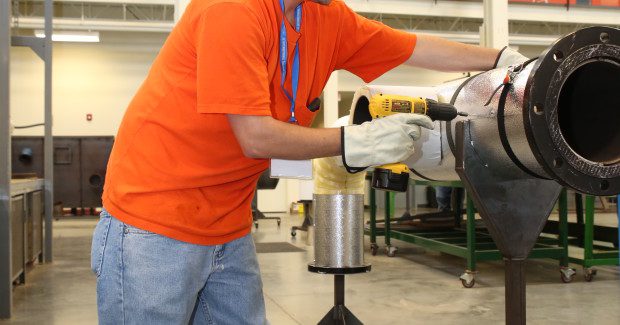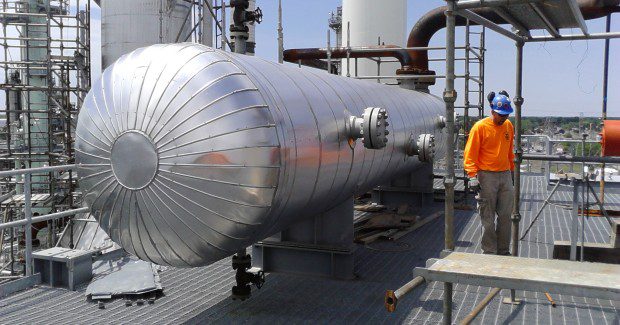A New Skill for Sheet Metal Workers
Lagging is in demand at power plants, nuclear power sites, paper mills, steel mills, refineries and other facilities.
Posted: February 1, 2016
It’s difficult to prepare for the future when it’s uncertain, but when an industry knows what’s on the horizon it just makes sense to get ahead of the curve. In 2015, nearly 65 sheet metal instructors traveled to St. Louis, MO, and Las Vegas, NV, to learn how to teach lagging. The 48-hour, six-day class, instructed by Jeff Peterson, the general foreman for API Group Inc. (New Brighton MN), gave seasoned professionals the technical aspects of the classroom and the hands-on training in the shop to take skills back to their training centers.
Lagging is a metal covering used to protect the insulation around pipes, tanks and other high temperature equipment from the elements. Lagging can commonly be found in power plants, nuclear power plants, paper mills, steel mills, refineries and other plants and it is in demand.
API Group, the multi-billion-dollar parent company for more than 40 independently managed construction companies worldwide, employs 400 to 500 workers specifically for lagging throughout the United States at any given time. According to Peterson, the company currently has eight to ten job sites across the country where sheet metal workers who can perform the skill are working. “When we come into an area, we want that area to have training available, so that they can train these guys and we don’t have to spend time doing it,” Peterson said. “Without a doubt, there is work waiting all over the U.S.”
The course, developed by Peterson and the International Training Institute (ITI; Fairfax, VA) the education arm of the unionized sheet metal industry, is meant to get ahead of the market and pass the training onto sheet metal workers at the local to take the work when it arrives. The question is: does the training attract the work or does the work demand the training?
Steve Kowats, an ITI staff and program coordinator, said that it can work both ways. The more proactive approach, however, is to train for the work, even when it’s not readily apparent. “Whether or not a given part of the country thinks they have this or that type of work, it’s out there,” he said. “There are existing customers out there and they shouldn’t be neglected.” Currently, lagging is critical and demand is increasing because more energy infrastructure is being constructed across the country.
“If contractors don’t believe they have any lagging work in their area, they could be looking in the wrong place,” added Kowats. “This way, sheet metal workers don’t have to turn down work because they don’t have the proper training. The program allows instructors to be proactive in regards to needed skills on the job sites rather than reacting to contractors when they need workers with certain skills and certifications. The skills the instructors learn during the course aren’t much different from the skills they already have to create sheet metal fittings and components. It’s just a little more advanced.”
“At the end of the day, the instructors take this knowledge back to their locals, students and training centers. Then, those workers take their skills to the job sites, which helps the contractors bid on jobs,” stated Mike Harris, a program administrator for the ITI. “It all works together.”
In Youngstown, OH, sheet metal workers are required to know many skills in order to keep working – from hanging ductwork and installing kitchen hoods to welding and industrial work. Kevin Rogers, a training coordinator for Local 33 in Youngstown, wants to give his apprentices and journeymen all the tools necessary to keep steadily working. The lagging program serves two purposes for Rogers and his program – apprentices will learn welding skills as they create the mock-ups this fall, in time for the lagging classes to take place in the spring. With two power plants scheduled for the area – and one to break ground next year – Rogers wants to get his students ahead of the game.
“I just want to do what I can to see that the next generation has the same prosperity as I had,” said Rogers. “If I can do something with the lagging program, and keep them working, I’m all for it.” This summer, participants received a completion certificate at the course’s end. However, an exam-based certification for lagging is on the horizon in the next year, said Chuck Holt, the director of research for the National Energy Management Institute Committee (NEMIC; Fairfax, VA), which scopes emerging markets for the unionized sheet metal industry.
In the meantime, instructors are preparing their locals for extra work; at least, that’s the goal. “If I can catch wind of something new and get ahead of the curve on training, I owe it to my guys to do that,” said Rogers. “I’m glad I went to the lagging class because it was well worth it.” Nearly 10,000 apprentices are registered at 153 training facilities in the U.S. and Canada.
The ITI is jointly sponsored by the International Association of Sheet Metal Air, Rail and Transportation Workers, (SMART; Washington, DC), formerly the Sheet Metal Workers’ International Association, and the Sheet Metal and Air Conditioning Contractors’ National Association (SMACNA; Chantilly, VA).
ITI supports apprenticeship and advanced career training for union workers in the sheet metal heating, ventilation, and air conditioning (HVAC), welding and industrial, architectural and ornamental, and service and testing, adjusting and balancing industry throughout the U. S. and Canada. ITI produces a standardized sheet metal curriculum supported by a wide variety of training materials free of charge to sheet metal apprentices and journeymen.
sheemetal-iti.org, www.nemionline.org,
www.smartunion.org, www.smacna.org












